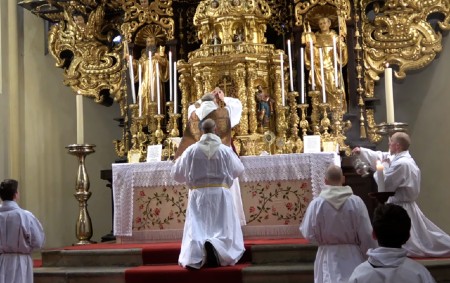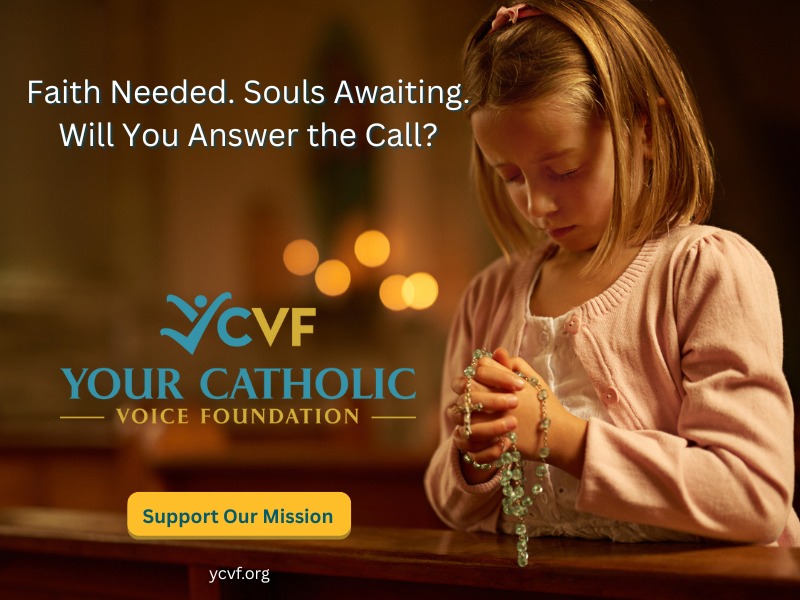We ask you, urgently: don't scroll past this
Dear readers, Catholic Online was de-platformed by Shopify for our pro-life beliefs. They shut down our Catholic Online, Catholic Online School, Prayer Candles, and Catholic Online Learning Resources essential faith tools serving over 1.4 million students and millions of families worldwide. Our founders, now in their 70's, just gave their entire life savings to protect this mission. But fewer than 2% of readers donate. If everyone gave just $5, the cost of a coffee, we could rebuild stronger and keep Catholic education free for all. Stand with us in faith. Thank you.Help Now >
The Timeless Power of the Latin Mass: A Wellspring of the World's Greatest Music
FREE Catholic Classes
Throughout centuries of history, no religious ritual or act of worship has left a greater mark on the world's greatest music than the ancient Latin Mass of the Catholic Church. The Latin Mass, or Missa Latina, stands at the intersection of faith, art, and human expression, inspiring some of the most extraordinary compositions in Western music. From the soaring works of Renaissance polyphony to the grandeur of classical symphonies, the Latin Mass has been the muse for composers seeking to channel the sacred through sound.

Image Credit: Wikimedia Commons
Highlights
9/25/2024 (1 year ago)
Published in Living Faith
Keywords: Latin Mass, Gregorian chant, Mass, History of Mass
Its intricate liturgical structure, timeless language, and profound spiritual depth have made the Latin Mass a wellspring for musical innovation and creativity. From Gregorian chant to the works of Bach, Mozart, and Verdi, the Mass has not only shaped sacred music but has also transcended the walls of the Church, influencing the entire landscape of classical music.
The Roots of Sacred Music: Gregorian Chant and the Early Church
The earliest music of the Latin Mass is found in Gregorian chant, which dates back to the early Middle Ages. This monophonic, unaccompanied sacred song, sung in Latin, became the official music of the Roman Catholic Church and laid the foundation for Western music. Each chant was carefully composed to reflect the solemnity and reverence of the Mass, aligning with the liturgical calendar and enhancing the experience of worship.
Gregorian chant's simplicity, its flowing melodies, and its emphasis on the prayerful recitation of sacred texts encapsulated the spiritual essence of the Mass. The rise of monasteries and religious orders, such as the Benedictines, helped preserve and promote this sacred tradition. Chant became synonymous with the Mass, marking the beginning of a long and evolving relationship between the Catholic liturgy and music.
Gregorian chant wasn't just the starting point for sacred music--it was the framework upon which later musical traditions were built. Its influence can still be heard in modern compositions, a testament to its timeless beauty and its foundational role in sacred music.
Renaissance Polyphony: The Flourishing of Choral Mass Settings
As the Middle Ages gave way to the Renaissance, music for the Latin Mass underwent a profound transformation. The development of polyphony--where multiple independent voices are sung together--opened the door to more complex and expressive compositions. Composers such as Giovanni Pierluigi da Palestrina, TomĂ¡s Luis de Victoria, and Orlando di Lasso wrote some of the most enduring choral works of the era, with the Mass at the heart of their musical output.
Palestrina, often regarded as the master of Renaissance polyphony, composed over 100 Masses, each showcasing his ability to balance intricate vocal lines with clarity and reverence for the liturgical text. His Missa Papae Marcelli remains one of the most celebrated works of the period, embodying the perfect union of art and worship. These compositions were more than just beautiful music--they were expressions of the sacred, designed to elevate the listener's soul toward God.
Renaissance polyphony, with its complex interwoven melodies and harmonies, expanded the spiritual and emotional possibilities of Mass music. It brought new depth and intensity to the worship experience, creating an atmosphere of contemplation and awe that continues to inspire choral music to this day.
The Baroque Explosion: Bach, Vivaldi, and the Majesty of the Mass
As the Renaissance gave way to the Baroque period, the Latin Mass continued to be a central focus for some of the greatest composers of all time. The Baroque era, with its emphasis on dramatic expression and emotional intensity, saw composers like Johann Sebastian Bach and Antonio Vivaldi channeling the power of the Mass into some of the most majestic works ever written.
Though Bach was a Lutheran, his Mass in B Minor is one of the most iconic settings of the Latin Mass in musical history. This monumental work, which is rarely performed in its entirety due to its scale, reflects the sheer emotional and spiritual range that the Latin Mass could inspire. Bach's composition moves seamlessly between moments of intimacy and grandeur, offering listeners a glimpse of the divine through its intricate counterpoint and expressive power.
Similarly, Vivaldi's Gloria exemplifies the Baroque exuberance that composers brought to the Latin Mass. His uplifting and energetic setting of the Mass's Gloria section captures the joy and reverence of worship, using the full force of choir and orchestra to convey the glory of God.
The Classical and Romantic Masters: Mozart, Beethoven, and Verdi
The Classical period continued the tradition of composing music for the Latin Mass, with composers like Wolfgang Amadeus Mozart elevating the art form to new heights. Mozart's Great Mass in C Minor and Requiem Mass are among the most beloved choral works in the classical canon. The Requiem, left unfinished at the time of Mozart's death, is particularly poignant--its combination of dramatic intensity and profound spiritual reflection captures the essence of the Mass as a journey toward the mystery of the divine.
Ludwig van Beethoven, though better known for his symphonies, also contributed to this tradition with his Missa Solemnis, a large-scale Mass that showcases the emotional and musical depth of his later work. Beethoven saw the Mass as an opportunity to explore the spiritual questions that preoccupied him throughout his life, and his setting is as much a personal expression of faith as it is a reflection of the liturgical text.
In the Romantic era, Giuseppe Verdi, known for his operas, composed a Requiem that stands as one of the most powerful settings of the Latin Mass. Though Verdi was not a deeply religious man, his Requiem expresses an intense reverence for the rituals of the Church and the mystery of death and the afterlife. With its dramatic contrasts and soaring melodies, Verdi's Requiem has become one of the most frequently performed sacred works, transcending its liturgical origins to become a staple of the concert stage.
The Continuing Influence of the Latin Mass
The Latin Mass has not only inspired the music of the past but continues to be a source of artistic creativity and spiritual expression in the modern era. Composers such as Maurice Duruflé, Francis Poulenc, and Arvo Part have drawn on the ancient liturgy to create works that resonate with contemporary audiences while remaining deeply connected to the sacred traditions of the Church.
In addition to its influence on classical music, the Latin Mass has also inspired modern film scores, choral music, and even popular music. Its timeless beauty, universal themes, and sense of transcendence have left an indelible mark on the cultural imagination, ensuring that the music of the Mass remains relevant in a rapidly changing world.
The Eternal Melody of the Mass
No other religious ritual has had the far-reaching impact on music that the Latin Mass has had. From the simple chants of the early Church to the grand symphonic settings of the classical and Romantic eras, the Mass has been a source of inspiration for some of history's greatest composers. It has shaped the very language of Western music, providing a template for the expression of spiritual longing, awe, and worship.
The Latin Mass endures as a wellspring of artistic creativity because it speaks to something eternal--the human desire to reach beyond the material world and encounter the divine. In its reverence, beauty, and complexity, the music inspired by the Mass reflects this timeless yearning, offering listeners a glimpse of the sacred through the universal language of music.
------------------------------------------------------------------------------------------
Your support makes stories like this possible!
Catholic Online is completely donor supported, allowing us to report on what truly is happening in the world, free of charge and uncensored. A donation to Catholic Online will ensure millions around the world can continue to come to our site to find the faith people are so desperately searching for in life.
Join the Movement
When you sign up below, you don't just join an email list - you're joining an entire movement for Free world class Catholic education.
- Advent / Christmas
- 7 Morning Prayers
- Mysteries of the Rosary
- Litany of the Bl. Virgin Mary
- Popular Saints
- Popular Prayers
- Female Saints
- Saint Feast Days by Month
- Stations of the Cross
- St. Francis of Assisi
- St. Michael the Archangel
- The Apostles' Creed
- Unfailing Prayer to St. Anthony
- Pray the Rosary
![]()
Copyright 2025 Catholic Online. All materials contained on this site, whether written, audible or visual are the exclusive property of Catholic Online and are protected under U.S. and International copyright laws, © Copyright 2025 Catholic Online. Any unauthorized use, without prior written consent of Catholic Online is strictly forbidden and prohibited.
Catholic Online is a Project of Your Catholic Voice Foundation, a Not-for-Profit Corporation. Your Catholic Voice Foundation has been granted a recognition of tax exemption under Section 501(c)(3) of the Internal Revenue Code. Federal Tax Identification Number: 81-0596847. Your gift is tax-deductible as allowed by law.










